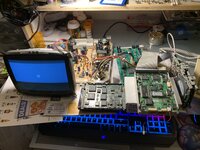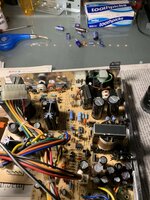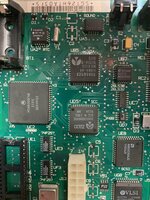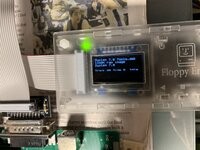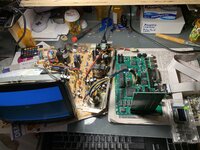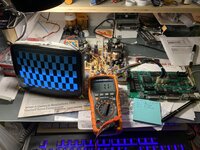Hello all, quick thank you to this community and the talented YouTubers I've followed for years now. It's been encouraging seeing such capable and approachable demonstrations on preserving this hardware history that I largely missed out on growing up, and behold, now have the chance to carry on with.
On the Table for me is a Macintosh Classic that was at one time last known working, but upon delivery presented with a sad mac Error 0000-000F 00000002/3 or equivalent errors. Since doing an analog power recap, and SMD Capacitor recap, deep clean, and reflow, I've been able to get it to reliably come to the boot screen and even access the ROM system. (So fast! So cool!)
I cannot, however, get it to recognize either the SCSI drive nor the floppy drive, even when swapped with known working parts from my SE Superdrive.
SCSI HDD spins up, head actuates within, but seems to stutter or dip in speed. System posts with disk icon
Floppy drive appears to actuate, spins up somewhat feebly, but never seeks or attempts to read any floppy disk I present it.
Voltages appear solid and steady : 4.89v and 12.10 +/- with load attached.
I have the means to replace the rest of the caps on the logic board, but no outward signs of damage to it or the logic board give me any solid leads as to where the disconnect may be. Unit only had typical oily cap surfaces with no major signs of corrosion aside from where the power supply caps on the analog board dripped onto the metal frame itself.
Any suggestions as to where I should prioritize troubleshooting?
Image 1 current state: all peripherals out on desk to access easier
Image 2 Analog board post recap
Image 3 worst extent of damages after removal of corroded SMD caps, prior to deep clean, reflow, and bodge. No evidence of any corrosive damage to any traces or chip legs that I can find.
On the Table for me is a Macintosh Classic that was at one time last known working, but upon delivery presented with a sad mac Error 0000-000F 00000002/3 or equivalent errors. Since doing an analog power recap, and SMD Capacitor recap, deep clean, and reflow, I've been able to get it to reliably come to the boot screen and even access the ROM system. (So fast! So cool!)
I cannot, however, get it to recognize either the SCSI drive nor the floppy drive, even when swapped with known working parts from my SE Superdrive.
SCSI HDD spins up, head actuates within, but seems to stutter or dip in speed. System posts with disk icon
Floppy drive appears to actuate, spins up somewhat feebly, but never seeks or attempts to read any floppy disk I present it.
Voltages appear solid and steady : 4.89v and 12.10 +/- with load attached.
I have the means to replace the rest of the caps on the logic board, but no outward signs of damage to it or the logic board give me any solid leads as to where the disconnect may be. Unit only had typical oily cap surfaces with no major signs of corrosion aside from where the power supply caps on the analog board dripped onto the metal frame itself.
Any suggestions as to where I should prioritize troubleshooting?
Image 1 current state: all peripherals out on desk to access easier
Image 2 Analog board post recap
Image 3 worst extent of damages after removal of corroded SMD caps, prior to deep clean, reflow, and bodge. No evidence of any corrosive damage to any traces or chip legs that I can find.

